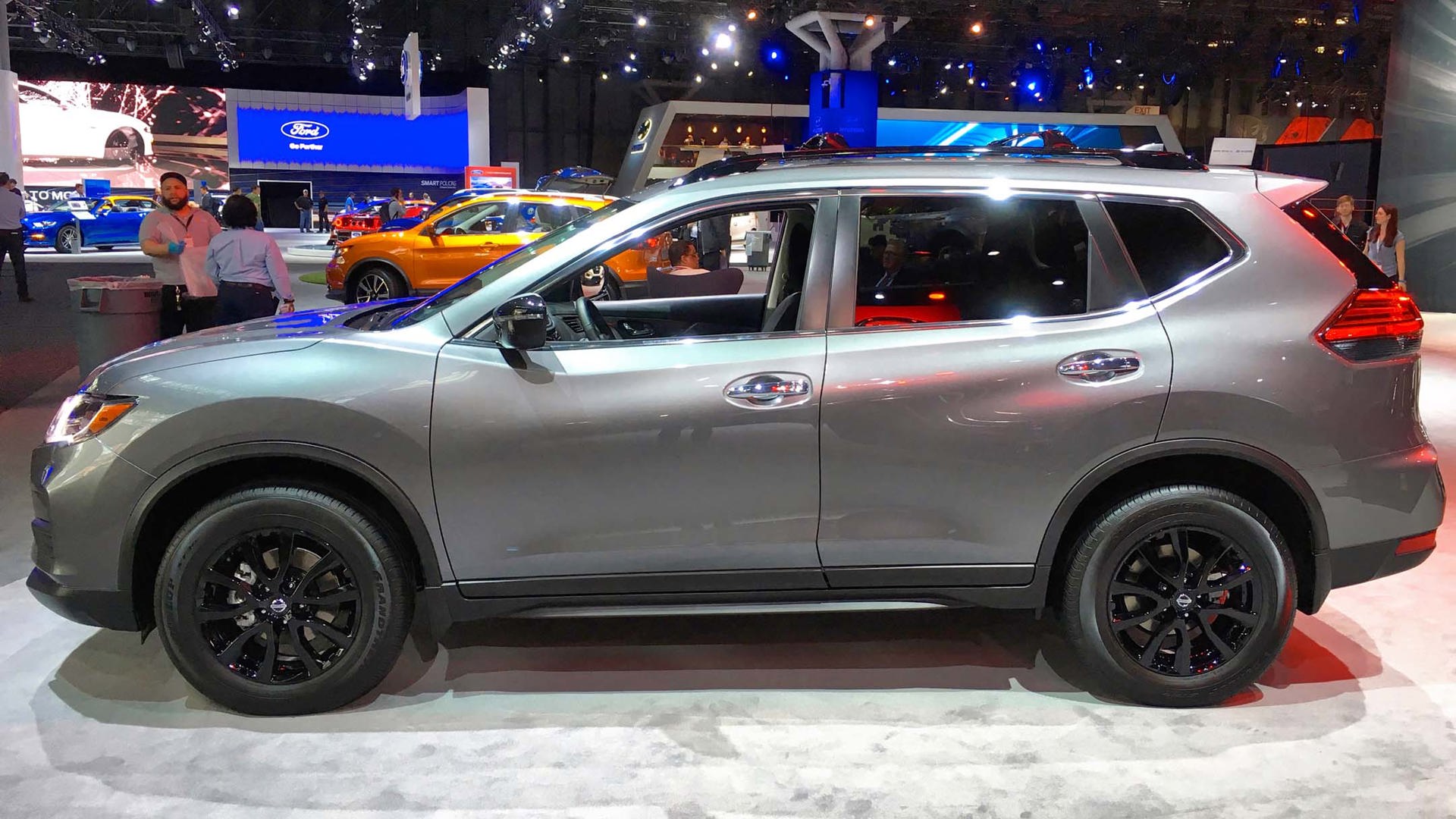NEW YORK– The viciously competitive CUV/crossover market is spreading like wildfire and frankly as challenging to pin down.
First, the buyers are not necessarily condo-dwelling millennials with big beards and bikes on the roof. They could be retirees, young families or remarried 50-somethings. The diversity of the buyers is down to the versatility of the vehicles. This car in this segment, perhaps more than most, represents an extension of the owners’ lives: vehicle life enabler.
The cars we’re discussing range almost as widely as the buying market. Some, like the Chevrolet Trax, look like smaller versions of their brand’s SUVs, while others like the completely redesigned Subaru Crosstrek look more like station wagons than utility vehicles. Outlying others, like the Kia Soul and new Toyota C-HR look like spaceships, while others still, like the Nissan Star Wars-branded Rogue, actually want to be spaceships.
 This spaceship is unfortunately not street-legal.
This spaceship is unfortunately not street-legal.
Live at the New York International Auto Show preview, eight reps of major auto manufacturers were invited to describe their bull’s-eye customer and a maximum of three reasons why that customer should choose their brand’s CUV or crossover (or spaceship) over the competitors. A sort of elevator speech to their buyer.
Not every rep was comfortable defining who their target market is because sometimes the people actually buying their product was quite different from what they’d pictured. Furthermore, not one of them was able to keep their list of reasons for buying their compact SUV to three. The request did at least encourage succinctness. The main themes were versatility, space, drivability, value, safety and fun.
Some of the cars below are not direct competitors, so the current base Canadian, pre-tax price is listed for perspective* (expect for the Toyota, which is being introduced to the market). There is no order to the list.
*Several of the vehicles pictured are 2018 models and have yet to release their in-store MSRP, so these prices are really just for ballparking perspectives.
Mazda CX-3

Jacob Brown, Mazda Specialist, Product Communications calls the CX-3 a “jack of all trades.” Its target is young singles or couples with no kids, “probably early professional life with an active lifestyle, probably more urban dwelling.” Why should they buy one? At 160 inches long, the CX-3 “is something you could use in a city like New York because it has all-wheel drive. It’s incredibly capable.” He tries to whittle down to just three reasons: “High quality and durability but good value. It almost won World Car Design last year, losing to the MX-5 Miata. You don’t have to spend $50,000 to get a beautiful, compelling all-weather vehicle.”
2017 from $20,695
Toyota C-HR

Emily, a product specialist with Toyota, talks about the customer for the introductory C-HR: “a younger, urban demographic. Mainly it’s people who like SUVs but want a smaller car that’s able to drive downtown, has good handling, good mileage and some fun.” She readily admits, “the CH-R doesn’t look like anything we’ve ever seen at Toyota.” The designers took cues for the look “from a diamond theme.” So, for example, she says to look on it from a profile, they got inspiration “from a diamond set on its side to provoke those notions of strength, luxury and edginess.” Those virtues express why the buyers would aspire to buy this new crossover. On the more practical side, it comes with Toyota Safety Sense standard at all trim levels.
New for 2018
Kia Soul

Neil Dunlop, Product and Technology Communications Manager from Kia PR, says the Soul’s buyer is not just the millennials they were pitching “but it’s across the board. One of the reasons that people like the Soul so much is the high ride height for egress and ingress.” Older people don’t want to bend down and crank themselves back up. “And, of course, the cargo space is a reason that people are buying.” That’s the practical reason to buy but he adds that the Soul is one of those vehicles which is relentlessly proud to be different. It’s a trait I recently dubbed “mobile urban jewelry”, outwardly expressing the driver’s desire for fun and style. As the name suggests, Dunlop adds, “the Soul has a fun spirit.”
2017 from $17,195
Chevrolet Trax

Joe Jacuzzi, the Executive Director, Global Chevrolet Communications brings up a point none others have yet. Every company will have a different way of expressing what he calls “conquest buyers”. There’s a popular marketing saw that it costs four times as much to get a customer as it does to keep one. Conquest buyers are those people you bring into a brand. Give them a good experience when they first come in and you’re far more likely to keep them and upgrade them to the next model. Trax customers are them. They “tend to be younger; over 50 percent female. And the top three reasons they’d choose Trax are space and storage, drivability and price.” Yes, that’s four but succinct.
2017 from $19,795
Volkswagen Tiguan

“When it comes to compact SUVs as you say,” Volkswagen PR specialist Jessica Anderson observes that the old Tiguan “was about 11 inches shorter than this model in terms of wheelbase. So it was the bottom of the segment in terms of size. Now it’s just jumped to the top” – barely qualifying for this quasi-comparison. The people buying it “are generally young families with one kid or two.” Which leads to the why to buy: “the vehicle is incredibly spacious inside” despite its small stature. “The Tiguan now also has an optional third row. It’s kind of a 5 plus 2. I might not put myself back there.” FYI, she’s short. “But for a kid, it’s great. Also the second row does slide forward enough so that you can adjust for whatever passenger configuration you have.”
2017 from $25,990
Nissan Rogue

Jimmy, a Product Specialist from Nissan says, “I would honestly say the Rogue does appeal to everyone. Whether it’s someone who’s looking for a sedan with all-wheel drive and better visibility – or it’s a person coming out of college, looking for more space. Or a family looking for more space as swell.” Again, the diversity of the buyers is down to the versatility of the vehicles. He attributes wider sales to a less constricting approach to buyers: “In the last three months we’ve become the bestselling crossover in the market because we’ve been able to appeal a wider set of the market, whether young or older population who likes to sit a little bit higher, it’s easier to get in and out, yet it’s still really affordable.”
2017 from $25,248
Mini Countryman

Mini Product Specialist Justin Berkowitz says the Countryman is “the most spacious Mini product ever offered.” Like the competitors, he talks about its versatile interior: “flexible and, at the same time, it retains all the hallmark values [of Mini].” The most important reasons for buying one? Outstanding handling, great performance, “and it’s fun.” He pauses. “It’s the vehicle that you might need but you want to drive.” A neat sound bite.
2017 from $26,990
Subaru Crosstrek

“You’ve seen it in our marketing, but it’s the truth. People that own Subarus are more likely to be outdoors and active: hiking, biking.” Todd Hill, Car Line Planning Manager of Subaru America says the completely redesigned Crosstrek’s buyers genuinely reflect the marketing materials: “later 20s, early 30s – more of them actually do have dogs!” What he believes makes the Crosstrek their best choice is that “this car is better suited to do all those [outdoorsy] things. You’ve got the ground clearance; we’ve just added X-mode, so it’s got a bit more capability. You can take this car off the beaten path. It’s got fully functional roof rails on the top. You can tow stuff with it.” Many others in this segment “don’t have a lot of ground clearance. They can’t tow. They don’t have a flexible roof rack.” He quickly adds safety, reliability and value before the microphone goes off.
2017 from $24,995







